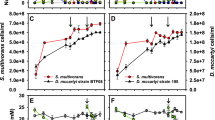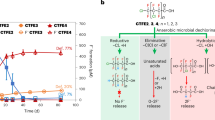Abstract
Chlorobenzenes are toxic, highly persistent and ubiquitously distributed environmental contaminants that accumulate in the food chain1. The only known microbial transformation of 1,2,3,5-tetrachlorobenzene (TeCB) and higher chlorinated benzenes is the reductive dechlorination to lower chlorinated benzenes under anaerobic conditions observed with mixed bacterial cultures2,3,4. The lower chlorinated benzenes can subsequently be mineralized by aerobic bacteria. Here we describe the isolation of the oxygen-sensitive strain CBDB1, a pure culture capable of reductive dechlorination of chlorobenzenes. Strain CBDB1 is a highly specialized bacterium that stoichiometrically dechlorinates 1,2,3-trichlorobenzene (TCB), 1,2,4-TCB, 1,2,3,4-TeCB, 1,2,3,5-TeCB and 1,2,4,5-TeCB to dichlorobenzenes or 1,3,5-TCB. The presence of chlorobenzene as an electron acceptor and hydrogen as an electron donor is essential for growth, and indicates that strain CBDB1 meets its energy needs by a dehalorespiratory process. According to their 16S rRNA gene sequences, strain CBDB1, Dehalococcoides ethenogenes5 and several uncultivated bacteria form a new bacterial cluster, of which strain CBDB1 is the first, so far, to thrive on a purely synthetic medium.
This is a preview of subscription content, access via your institution
Access options
Subscribe to this journal
Receive 51 print issues and online access
$199.00 per year
only $3.90 per issue
Buy this article
- Purchase on Springer Link
- Instant access to full article PDF
Prices may be subject to local taxes which are calculated during checkout


Similar content being viewed by others
References
Oliver, B. G. & Nicol, K. D. Chlorobenzenes in sediments, water, and selected fish from lakes Superior, Huron, Erie, and Ontario. Environ. Sci. Technol. 16, 532–536 (1982).
Tiedje, J. M., Boyd, S. A. & Fathepure, B. Z. Anaerobic degradation of chlorinated aromatic hydrocarbons. J. Ind. Microbiol. Suppl. 27, 117–127 (1987).
Fathepure, B. Z., Tiedje, J. M. & Boyd, S. A. Reductive dechlorination of hexachlorobenzene to tri- and dichlorobenzenes in anaerobic sewage sludge. Appl. Environ. Microbiol. 54, 327–330 (1988).
Beurskens, J. E. M. et al. Dechlorination of chlorinated benzenes by an anaerobic microbial consortium that selectively mediates the thermodynamic most favorable reactions. Environ. Sci. Technol. 28, 701–706 (1994).
Maymó-Gatell, X., Chien, Y. T., Gossett, J. M. & Zinder, S. H. Isolation of a bacterium that reductively dechlorinates tetrachloroethene to ethene. Science 276, 1568–1571 (1997).
Holliger, C., Wohlfarth, G. & Diekert, G. Reductive dechlorination in the energy metabolism of anaerobic bacteria. FEMS Microbiol. Rev. 22, 383–398 (1999).
Hugenholtz, P., Pitulle, C., Hershberger, K. L. & Pace, N. R. Novel division level bacterial diversity in a Yellowstone hot spring. J. Bacteriol. 180, 366–376 (1998).
von Wintzingerode, F., Selent, B., Hegemann, W. & Göbel, U. B. Phylogenetic analysis of an anaerobic, trichlorobenzene-transforming microbial consortium. Appl. Environ. Microbiol. 65, 283–286 (1999).
Bosma, T. N. P., van der Meer, J. R., Schraa, G., Tros, M. E. & Zehnder, A. J. B. Reductive dechlorination of all trichloro- and dichlorobenzene isomers. FEMS Microbiol. Ecol. 53, 223–229 (1988).
Holliger, C., Schraa, G., Stams, A. J. M. & Zehnder, A. J. B. Enrichment and properties of an anaerobic mixed culture reductively dechlorinating 1,2,3-trichlorobenzene to 1,3-dichlorobenzene. Appl. Environ. Microbiol. 58, 1636–1644 (1992).
Middeldorp, P. J. M., de Wolf, J., Zehnder, A. J. B. & Schraa, G. Enrichment and properties of a 1,2,4-trichlorobenzene-dechlorinating methanogenic microbial consortium. Appl. Environ. Microbiol. 63, 1225–1229 (1997).
Adrian, L., Manz, W., Szewzyk, U. & Görisch, H. Physiological characterization of a bacterial consortium reductively dechlorinating 1,2,3- and 1,2,4-trichlorobenzene. Appl. Environ. Microbiol. 64, 496–503 (1998).
Adrian, L., Szewzyk, U. & Görisch, H. Bacterial growth linked to reductive dechlorination of trichlorobenzenes. Biodegradation (in the press).
Giesbrecht, P., Kersten, T., Maidhof, H. & Wecke, J. Staphylococcal cell wall: morphogenesis and fatal variations in the presence of penicillin. Microbiol. Mol. Biol. Rev. 62, 1371–1414 (1998).
Ludwig, W. et al. Bacterial phylogeny based on comparative sequence analysis. Electrophoresis 19, 554–568 (1998).
Pfennig, N. Rhodocyclus purpureus gen. nov. and sp. nov., a ring-shaped, vitamin B12-requiring member of the family Rhodospirillaceae. Int. J. Syst. Bacteriol. 28, 283–288 (1978).
Zehnder, A. J. B. & Wuhrmann, K. Titanium(III) citrate as a nontoxic oxidation-reduction buffering system for the culture of obligate anaerobes. Science 194, 1165–1166 (1976).
Kalmbach, S., Manz, W. & Szewzyk, U. Isolation of new bacterial species from drinking water biofilms and proof of their in situ dominance with highly specific 16S rRNA probes. Appl. Environ. Microbiol. 63, 4164–4170 (1997).
Bade, K., Manz, W. & Szewzyk, U. Behavior of sulfate reducing bacteria under oligotrophic conditions and oxygen stress in particle-free systems related to drinking water. FEMS Microbiol. Ecol. 32, 215–233 (2000).
Acknowledgements
We thank T. Tran and P. Wendler for technical assistance. This work was supported by the Deutsche Forschungsgemeinschaft.
Author information
Authors and Affiliations
Corresponding author
Rights and permissions
About this article
Cite this article
Adrian, L., Szewzyk, U., Wecke, J. et al. Bacterial dehalorespiration with chlorinated benzenes. Nature 408, 580–583 (2000). https://doi.org/10.1038/35046063
Received:
Accepted:
Issue Date:
DOI: https://doi.org/10.1038/35046063
This article is cited by
-
Cultivation of marine bacteria of the SAR202 clade
Nature Communications (2023)
-
Only mass migration of fungi runs through the biotopes of soil, phyllosphere, and feces
Journal of Soils and Sediments (2021)
-
Identification and characterization of a bacterial core methionine synthase
Scientific Reports (2020)
-
Deiodination in the presence of Dehalococcoides mccartyi strain CBDB1: comparison of the native enzyme and co-factor vitamin B12
Environmental Science and Pollution Research (2019)
-
Shifts among Eukaryota, Bacteria, and Archaea define the vertical organization of a lake sediment
Microbiome (2017)
Comments
By submitting a comment you agree to abide by our Terms and Community Guidelines. If you find something abusive or that does not comply with our terms or guidelines please flag it as inappropriate.



